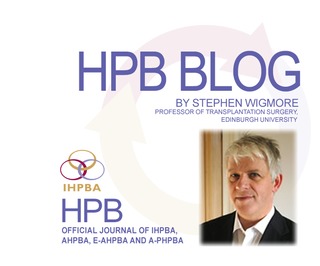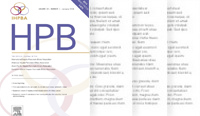International Hepato-Pancreato-Biliary Association
HPB Blog, December 2017

December is here again and as part of the festive season HPB has some gifts for you.
Nassour and coleagues from University of Texas South Western have developed a nomogram to predict which patients are likely to not be discharged home after pancreaticoduodenectomy based on a national cohort of patients. Predicting discharge destination may be useful and it would be interesting to develop a web based version of this tool. Chu and colleagues from Louisiana looked at survival after pancreas cancer surgery in different types of institution and found best outcomes resulting for patients treated in Academic Research Programs (ARP) compared with Community Cancer programs or Comprehensive Community Cancer Centers. The exact reasons for the improved survival in ARP programs was not clear but if it is possible to define key factors they may be transferrable to other care models.
Technology often features among gifts at Christmas and we have two offerings for you. First a paper from Rombouts and colleagues for Utrecht, Netherlands describes a large animal study of irreversible electroporation of the pancreas which showed acceptable safety profiles and is encouraging for human application for tumours. The second from Sastry and colleagues at the Carolinas Medical Center describes a novel 3 dimensional electromagnetic guidance system to improve the accuracy of microwave antenna placement for ablation procedures.
For the liver transplanters, we have a paper on the impact of body mass index in liver transplantation for non-alcoholic fatty liver disease and alcoholic liver disease from O’Neill and colleagues from my own unit, showing that by 5 years post transplant BMI had fallen in the NAFLD patients to be the same as patients with alcohol related liver disease. Uchiyama and colleagues explored the Kyushu University criteria for transplantation for hepatocellular carcinoma and showed that these criteria can select patients beyond Milan criteria for successful living donor liver transplantation with good outcomes.
The ALPPS procedure makes an appearance once again with two papers in this edition. The first from Alexandrino and colleagues from Coimbra looks at the bioenergetics status of the liver during the different stages of the ALPPS procedure and show data suggesting that bioenergetics status might have some predictive value in terms of liver health and recovery. The second study is a multicenter registry study lead by Enne which describes the use of ALPPS as a salvage procedure for patients who have not developed sufficient future liver remnant growth following portal vein occlusion through ligation or embolization.
Two more papers present predictive nomograms or calculators for patients undergoing HPB surgery. Beal and colleagues evaluated the National Surgical Quality Improvement project calculator for common risks in patients undergoing gall bladder cancer or extrahepatic bile duct cancer surgery. Spaulding and Martin from Kentucky describe an evaluation of a preoperative scoring system to predict adverse outcome after hepatectomy. Finally some beautiful illustrations feature in the paper from Fukutomi and colleagues from Fukuoka, Japan, who look at spread of hepatocellular carcinoma using 3 dimensional portal vein territory mapping.
We hope that everyone will enjoy the December issue of HPB and from all of the editorial team we wish you “happy holidays”.
Corporate Partners
If you are interested in becoming a Corporate Partner of the IHBPA please contact industry@ihpba.org
Find out more


